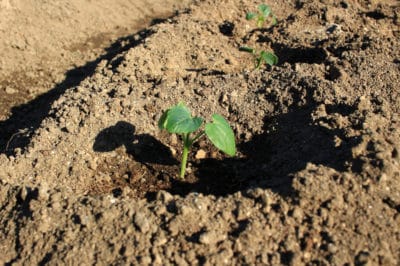Preparing Okra Seeds for Planting
Okra seeds have a hard, protective coating that can interfere with germination. Before sowing your seeds you need to prepare them for planting. You have three choices:
- Wrap the seeds in moist paper towels overnight.
- Soak the seeds for 12 to 18 hours to soften the coating.
- Use a file to create nicks in the surface of each seed.
Because each okra plant produces so many pods, you only need four or five plants unless you are planning on saving the seeds or pickling, canning, or freezing okra for the winter. Consequently, any of these methods is effective, but soaking the seeds still is probably the most efficient.
Preparing the Soil for Okra
You should till the soil at the end of the growing season. You should also have your local extension agency test your soil in the fall if you don’t know its pH and nutrient levels. Okra can grow in many soil conditions, but it prefers well-drained, loamy or sandy soil with a pH level of 6.0 to 6.5 that is rich in organic materials.
If your soil’s pH level is above 7.6, your extension agency will be able to tell you how much lime you need to add to your soil to increase its acidity. The lime should be added in the fall.
You may also need to add organic fertilizers to your soil to increase nutrient levels. Some of these need to age and should be added about a month before planting your okra. You also can work a 2 to 3 inch layer of rich compost or aged manure into the soil to a depth of 15 inches just before planting.
Choosing Your Okra Patch
Okra does not tolerate shade. It needs six to eight hours of full sun, and it likes the heat. Peas fix nitrogen into the soil as they grow, so rotating your okra and pea patches each growing season is a good idea. If you are planning on planting and saving the seed of more than one variety of okra, you should keep them 500 to 1,600 feet apart to prevent cross pollination.
Sowing Okra Seeds Directly into Your Garden
Okra is a tall plant that requires a lot of room. Rows of okra should be 2 to 3 feet apart. You can plant the seeds 3 inches apart, but when the seedlings are 2 to 3 inches tall, you should remove the weaker plants so that the strongest plants are 18 to 24 inches apart.
How deep you plant the seeds depends on your soil and your climate. Okra can grow to be 6 to 8 feet tall or more. If you live in a windy area, and especially if you have clay soil that cracks when it dries out, stability becomes an issue. In such a situation, you should plant your okra seeds 1 or even 2 inches deep and stake your plants with 6 foot or 8 foot tree stakes.
You can also intersperse your okra with radishes because the radishes will help break up the soil and enable your okra roots to grow deeper.
In loamy or sandy soil where windy conditions are not an issue, using a hoe to create a trough that is 1/2 inch to 1 inch deep is a sufficient depth for planting okra outdoors.
Planting Okra in Containers
The container you choose and how you plant your seeds in it depends on whether you are starting your okra indoors for transplanting into your garden, planning on letting the okra grow to maturity in the container, or growing your okra for sprouts.
If you are starting your seeds for later transplanting, use peat moss starter pots and plant two seeds per pot. When the seedlings are 2 to 3 inches high, snip off the weaker plant. Wait until temperatures warm to around 60°F (16°C) at night and daytime temperatures warm to 85°F (29°C) to transplant your seedlings. Water them before transplanting, and either carefully remove the pot, leaving the soil around the root intact, or, better, carefully slit the sides of the pot and transplant your seedlings pot and all.
If you are growing okra sprouts, choose a shallow container and pack the seeds closely together. You can harvest them as soon as they sprout.
If you are growing your okra to harvest the pods, choose a dwarf variety like Baby Bubba or Cajun Jewel. Your container should be at least 14 inches deep, and if you plan on growing your okra in individual pots, the containers should be 14 inches in diameter.
Sow two seeds 1/2 inch deep and remove the weaker plant when the seedlings are 2 to 3 inches tall. If you are using a planter to hold multiple okra plants, choose one that allows 18 to 24 inches between the plants. You can fill in with companion plants like radishes, lettuce, or flowers that will attract pollinators.
Whenever you grow any plant in a container, keep in mind that topsoil is too heavy for container gardening and doesn’t allow for sufficient drainage. Use a potting soil blended for vegetable, herbs and vegetables, or flowering plants, depending on what you are growing.
